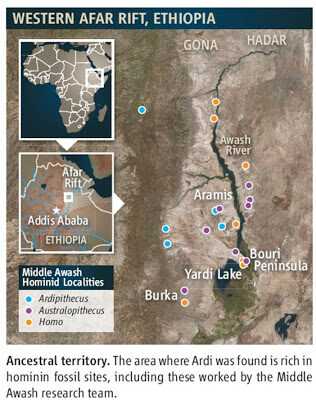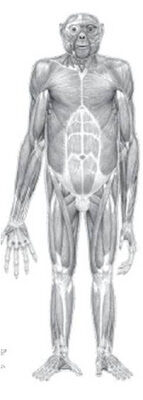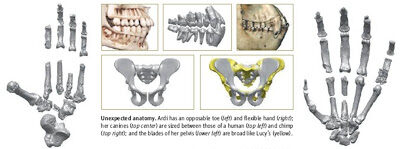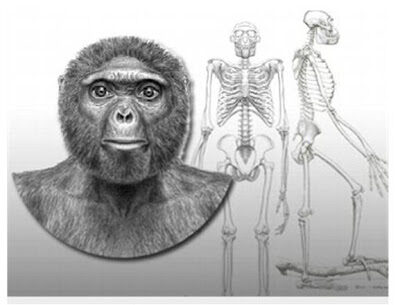[note: this essay was written in Oct. 2009 AD but is just now being re-posted from the blog in which it was originally posted]
A new chapter in the various tales of human evolution have begun being written on October 1, 2009 AD as an 18 year old fossil find has been brought to light.
Recall that mere months ago Ida was the missing link, this time Ardipithecus Ramidus, aka Ardi, is reportedly the most recent much ado. Though she is said to not be the missing link she is reportedly “a 4.4-million-year-old human forebearer.” Ardi is “a million years older than the iconic bones of Lucy, the primitive female figure that has long symbolized humankind’s beginnings.”
Of course, the controversy and or scholarly debate begins here as she is not thought to be the mythical-crypto-zoological common ancestor. In fact, “scholars argue whether these creatures should be counted among our most ancient direct ancestors or cataloged as an intriguing dead-end.” And with that; all the bases are covered via an appeal to both extremes.
While the closer we get to finding the crypto-creature the more we expect to find something more akin to an ape, Ardi has evolutionists (of the common ancestor sort) revising their speculations and thinking that it will be more human-like than not, “our earliest ancestors were more modern than scholars assumed…the discoveries have experts reworking the human pedigree.” Tim White, a paleoanthropologist at the University of California, Berkeley stated, “It is not a chimp and it is not human…It gives us a new perspective on our origins.”
It is said that the fossils represented by Ardi “were already starting to presage humanity.” Of course, this is a matter of interpretation as they do not know to whom Ardi gave birth, if she did at all, and also because she and her kind could simply represent a “dead-end.” In this regard stating that “humans, apes and chimps…all shared a common ancestor six million years or so ago” is something that represents an a priori conclusion via a school of thought and not an a posteriori based on observation of evidence.
This possible “dead-end” is also said to “take its place in the gallery of human origins…the earliest known skeleton from the human branch of the primate family tree” and what can a possible dead-end tell us about what “the early members of the human family look like?” well, “Now, that question is being answered in detail for the first time.”
Thus, it is, in part, being claimed that “humans did not evolve from chimpanzee-like ancestors…Instead, the missing link…was different from both…we found something pretty close to it…‘Ardi’ is clearly a human ancestor and her descendants did not grow up to be chimpanzees or other apes.” It is fascinating how one could know such things. Just prior to this unveiling the experts upon whom we all place such trust would have stated something quite different, today it is this, tomorrow that and unless you follow the carrot dangling in from of your face you are some sort of scientifically unenlightened fanatic.
In Ardi they found something pretty close to something which no one has ever seen and which is known to have existed only in quaint Victorian Era theories. Ardi was a completely unexpected find but we can know that she is a human ancestor and not that of chimps or other apes.
Though not involved with the fossil find Harvard anthropologist David Pilbeam has served as somewhat of a spokesman and arbiter of opinion. He has stated, “one of the most important discoveries for human evolution. The find itself is extraordinary, as were the enormous labors that went into the reconstruction of a skeleton shattered almost beyond repair.” He considers this “one of the most important discoveries for human evolution.” That is just fine, but keep in mind that this is the estimation of the same David Pilbeam who has stated,
A major change is a growing realization that many evolutionary schemes are in fact dominated by theoretical assumptions that are largely divorced from data derived from fossils, and that many assumptions have remained implicit…virtually all our theories about human origins were relatively unconstrained by fossil data…The theories are…fossil-free or in some cases even fossil-proof.[1]
I have come to believe that many statements we make about the hows and whys of human evolution say as much about us, the paleoanthropologists and the society in which we live, as about anything that “really” happened.[2]
Thus, the difficultly, if not impossibility, of parsing between the evidence and the interpretation of evidence (I presented vast amounts of examples of such in my essay Scientific Cenobites).
Consider that C. Owen Lovejoy, anatomist at Kent State University, “speculated that these hominids had a social system that involved less competition among males and that this suggested the beginning of pair bonding between males and females” the “males of the species did not fight each other for the females’ attention…It is likely that the males went looking for food and brought it back to the females, possibly in return for sex, though that’s another story….This was probably a species for which male aggressiveness was not something that led to evolutionary success.”
But upon what evidence was C. Owen Lovejoy painting such vividly detailed pictures of the lifestyles of Ardipithecus Ramidus 4.4 million years ago? “The shape of the large canine teeth in the front of the jaw is important. Male teeth were no larger than females’. It provides clues about social structure…” No wonder that David Pilbeam “disputed this conjecture, saying, ‘This is a restatement of Owen Lovejoy’s ideas going back almost three decades, which I found unpersuasive then and still do.”
Thus, evidence is irrelevant, teeth are irrelevant but a favorite theory is merely inserted into a convenient gap in our knowledge even though it was conceived before the teeth were found, inspected and interpreted.
Of interest, and concern to me, is that,
The skull, for example, was in so many pieces it had to be reconstructed digitally, requiring hundreds of CAT scans and 1,000 hours of computer processing. The pelvis alone took six years to reconstruct…
Most researchers…praise the detailed reconstructions needed to piece together the crushed bones.
Indeed, the arduous work of reconstruction is important to such endeavors yet, this also adds to the possibility of interpretation being literally responsible for the manipulation of evidence via self-serving reconstructions. Such examples are legion such as chimps or other apes reconstructed with whites in their eyes, nose shapes when cartilage does not fossilize, etc.
For a more specific example consider the issue of reconstructing Skull 1470:
One point of uncertainty was the angle at which the face attached to the cranium. Alan Walker remembers an occasion when he, Michael Day, and Richard Leakey were studying the two sections of the skull. “You could hold the maxilla forward, and give it a long face, or you could tuck it in, making the fact short,”[3] he recalls. “How you held it really depended on your preconceptions. It was very interesting watching what people did with it.”
Leakey remembers the incident too: “Yes. If you held it one way, it looked like one thing; if you held it another, it looked like something else. But there was never any doubt that it was different. The question was, was it sufficiently different from everything else to warrant being called something new?”[4]
Thus,
not everyone agrees with the team’s interpretations about how Ar. ramidus walked upright and what it reveals about our ancestors. “The authors … are framing the debate that will inevitably follow,” because the description and interpretation of the finds are entwined, says Pilbeam. “My first reaction is to be skeptical about some of the conclusions”…
The pelvis…offers only “circumstantial” evidence for upright walking…
“this raises the intriguing possibility that we’re looking at the same genus” for specimens now put in three genera, says Pilbeam. But the discoverers of O. tugenensis aren’t so sure. “As for Ardi and Orrorin being the same genus, no, I don’t think this is possible, unless one really wants to accept an unusual amount of variability” within a taxon, says geologist Martin Pickford of the College de France…
several researchers aren’t so sure about these inferences. Some are skeptical that the crushed pelvis really shows the anatomical details needed to demonstrate bipedality. The pelvis is “suggestive” of bipedality but not conclusive, says paleoanthropologist Carol Ward of the University of Missouri, Columbia. Also, Ar. ramidus “does not appear to have had its knee placed over the ankle, which means that when walking bipedally, it would have had to shift its weight to the side.”
In any regard this essay is merely as preliminary as the reports which are just now surfacing as the fossils, interpretations, media frenzy and polemics rear their good, bad and ugly heads.
~~~~~~~~~~~~~
All quotations were gleaned from the following:
Robert Lee Hotz, “Fossils Shed New Light on Human Origins,” The Wall Street Journal, October 1, 2009
Maggie Fox, “Discovery in Ethiopia Casts Light on Human Origins,” ABC News, October 1, 2009
David Perlman, “The oldest known prehuman revealed,” SF Gate, October 1, 2009
John Noble Wilford, “Fossil Skeleton From Africa Predates Lucy,” New York Times, October 1, 2009
Ned Potter, “‘Ardi:’ 4.4 Million-Year-Old Fossil is Oldest Human Ancestor,” ABC News, Oct. 1, 2009
Ann Gibbons, “Ancient Skeleton May Rewrite Earliest Chapter of Human Evolution,” Science, 1 October 2009
Footnotes:
[1] Ann Gibbons, “A New Kind of Ancestor: Ardipithecus Unveiled,” Science, 2 October 2009, VOL 326
[2]“Current Argument on Early Man,” in Major Trends in Evolution, edited by Lars-Konig Konigson, published by Pergamon Press, 1980, pp. 262, 267
[3] “Rethinking Human Origins,” in Discovery, vol. 13, p. 9 (1978)
[4] Roger Lewin, Bones of Contention (New York, NY: A Touchstone Book published by Simon & Schuster Inc., 1987), p. 160 citing an interview with the author, Potomac, Maryland, 5 Aug. 1984
[5] Ibid., p. 160 citing an interview with the author, Nairobi, 21 Jan. 1985
~~~~~~~~~~~~~~~~~~~~~~~~
A plea: I have to pay for server usage and have made all content on this website free and always will. I support my family on one income and do research, writing, videos, etc. as a hobby. If you can even spare $1.00 as a donation, please do so: it may not seem like much but if each person reading this would do so, even every now and then, it would add up and really, really help. Here is my donate/paypal page.
Due to robo-spaming, I had to close the comment sections. However, you can comment on my Facebook page and/or on my Google+ page.




